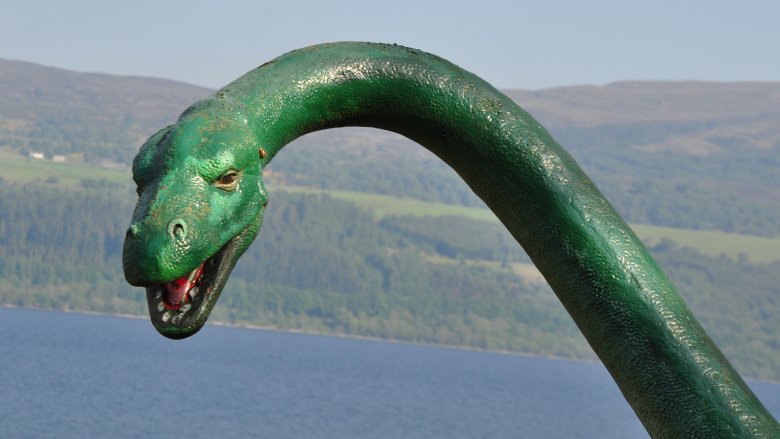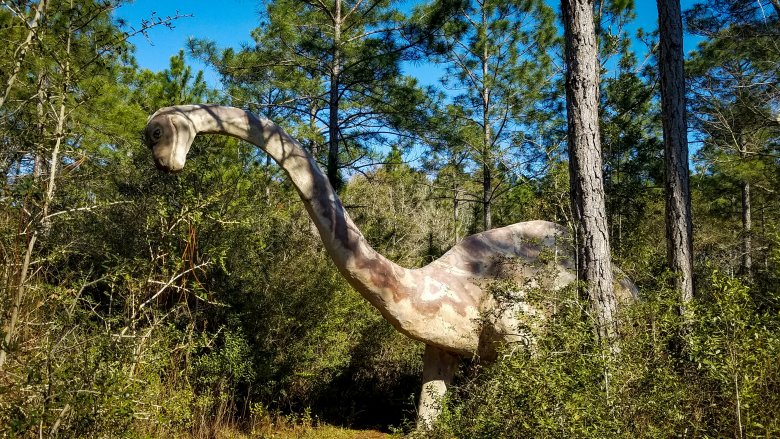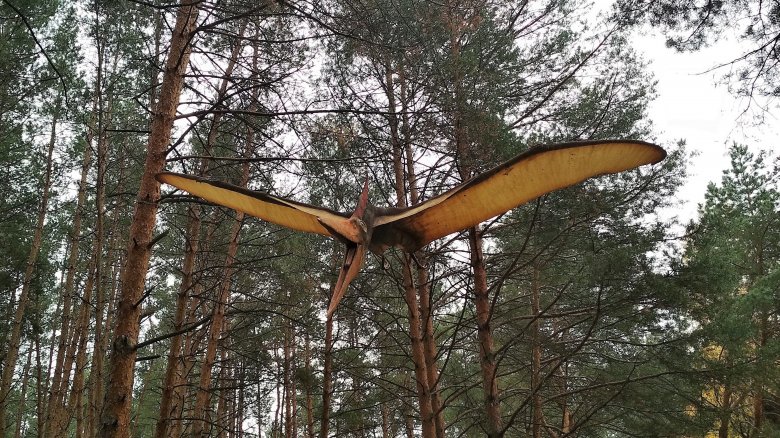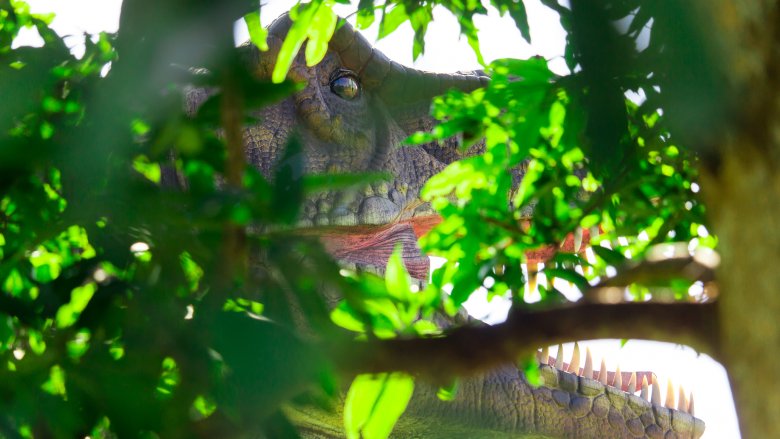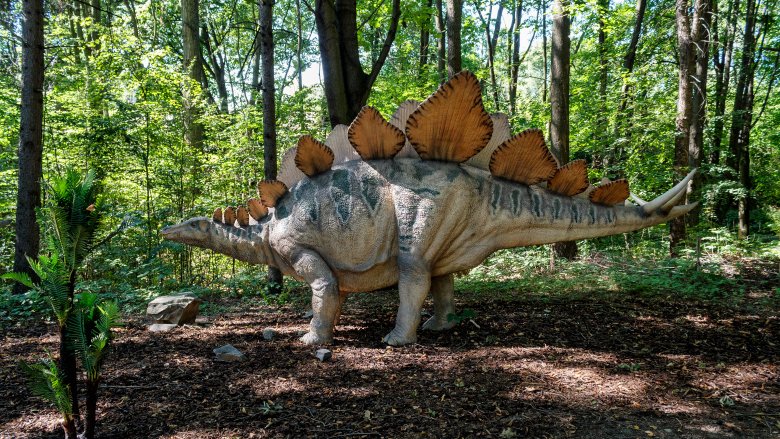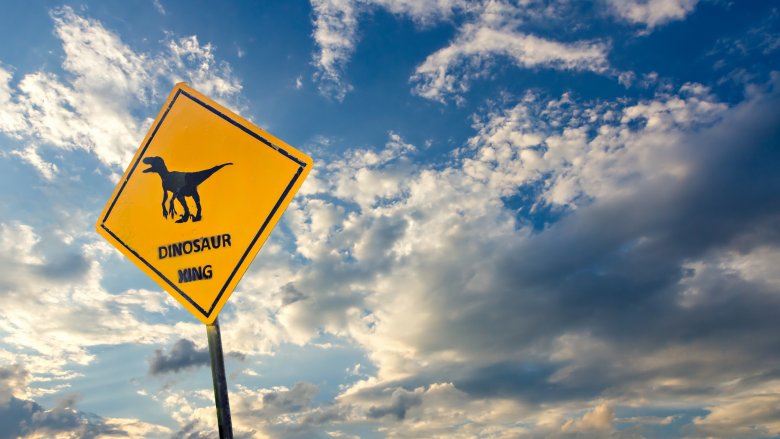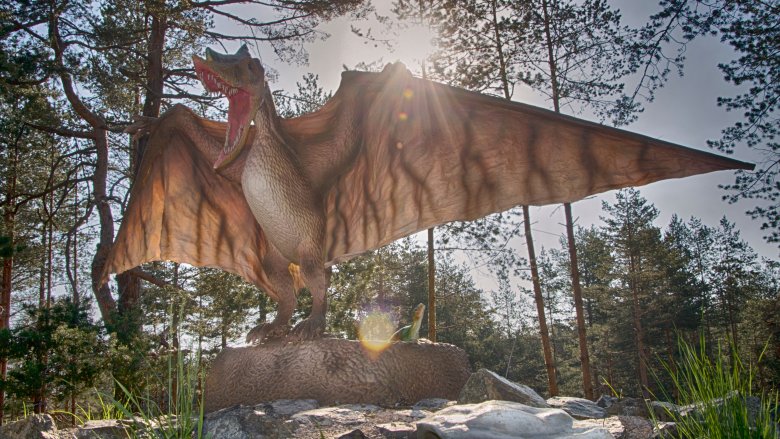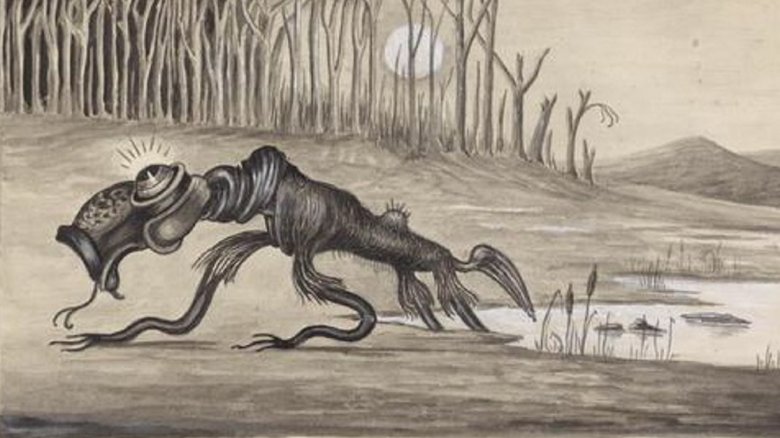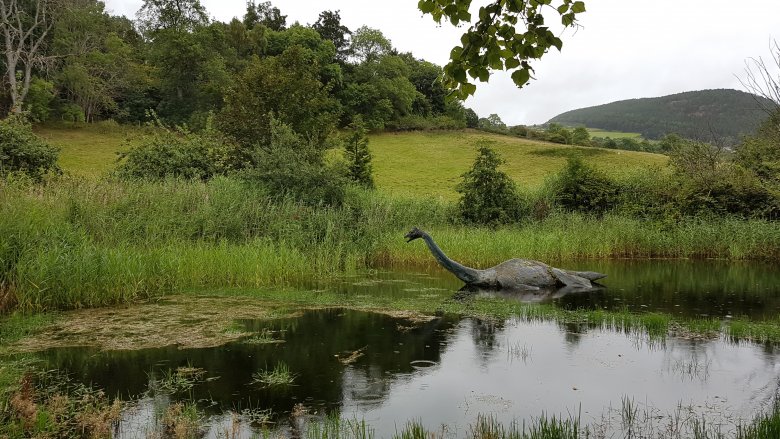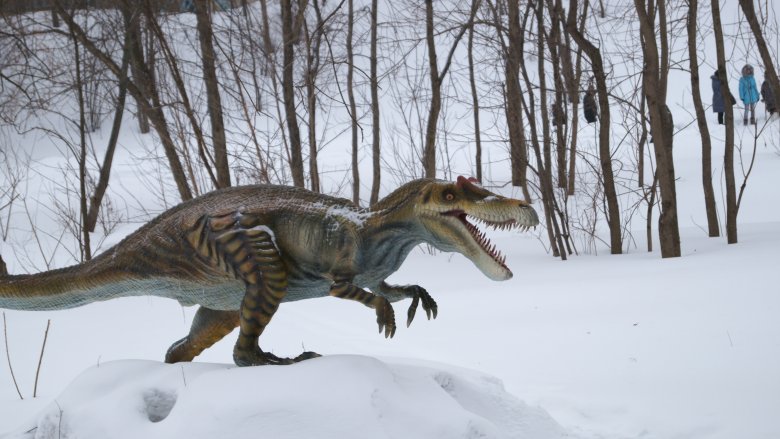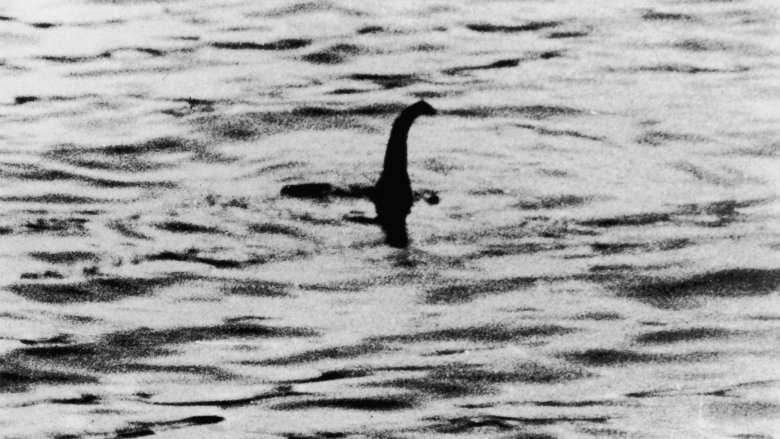Dinosaurs That Some People Think Are Still Alive Today
Once upon a time, reptilian giants ruled the planet. From the terrifying jaws of the Tyrannosaurus rex to the swooping neck of the Diplodocus, the sheer variety of dinosaurs that walked the Earth is only slightly less amazing than the fact that every six-year-old can memorize all their quirky Latin names. Unfortunately for the dinosaurs — though, rather fortunately for mammals — the reptile empire ended about 66 million years ago, when an asteroid smacked into Earth. While some dinosaurs evolved into birds, the rest of these giant prehistoric animals were wiped out, forever.
Or were they? If you ask some folks in cryptozoology circles, they'll tell you that a few dinos are still roaming about, whether they're swimming in Loch Ness or stomping through the Australian Outback. Now, to be clear, there's no truly verifiable evidence to suggest these creatures are around in anything but Jurassic Park movies. Nonetheless, legends persist, probably because it's a whole lot of fun to imagine that dinosaurs are still alive today.
Say hello to the last Brontosaurus in the world
According to legend, the dense rainforests of the Democratic Republic of the Congo hide one of the last great undiscovered wonders of the world, a mysterious creature of epic proportions. This massive animal, known as Mokele-mbembe — in the Lingala dialect, "one who stops the flow of rivers," according to Herman A. Regusters — is said to be 35 feet long, with grayish skin and a long neck. Eyewitnesses report the monster resembles a Brontosaurus, as LiveScience explains, other than the fact that Mokele-mbembe is no gentle, plodding vegetarian. When this beast emerges from the riverbank, it allegedly devours crocodiles, hippos, and elephants. Say whaaaa?
Anyhow, legends about a living Brontosaurus in the Congo aren't a recent phenomenon. The first published reference to Mokele-mbembe occurred in the 1909 book Beasts and Men by Carl Hagenbeck, a showboating zoologist who tried to find the creature. His journey proved fruitless, but he still came away believing it was real.
Hagenbeck wasn't the last foreign invader to hunt for Mokele-mbembe, of course. More recently, the so-called "Newmac Expedition" was a Kickstarter campaign by a bunch of inexperienced kids, which somehow raised almost $28,000 in the promise of finding the animal. Speaking to The Huffington Post, expedition lead Stephen McCullah emphasized that he planned to bring the legendary creature back alive, rather than dead, by using tranquilizer rifles. Guess he never saw Spielberg's The Lost World, huh? Unsurprisingly, the Newmac Expedition failed miserably, according to the Sun-Sentinel.
Iowa gets visited by a pterosaur
Sure, pterosaurs aren't technically dinosaurs, but they're big, scaly, and completely extinct. Well, maybe. Over the years, a lot of people have reportedly seen these winged beasts going about their reptilian business. But while there are a lot of places you might expect to find a pterosaur flapping around, small town Iowa isn't one of them ... unless you've heard the legend of the Van Meter Visitor.
This bizarre series of events went down in 1903, according to The Des Moines Register, when a number of prominent, respected men in the town of Van Meter all reported witnessing a terrifying flying reptile with bat wings, complete with three-toed tracks, a nasty stench, and ... uh, a glowing light that emanated from its forehead. Sorry, no explanation for that last part. This being the early 1900s, the creature was probably regarded as some demonic entity, so — after a couple nights of chaos — the men formed a shotgun brigade and went dino-hunting. They eventually heard the monster shrieking from the abandoned coal mine and went to investigate. There, they found the Van Meter Visitor and its child, both of which flapped away into the darkness, never to visit Iowa again.
Yes, this sounds like a goofy B-movie. However, it's rather unusual that the men who reported the incident were well-to-do figures, rather than neighborhood cranks. These guys had nothing to gain (and a lot to lose) from telling such a tall tale. That doesn't prove anything, of course, but it has kept the story circulating throughout the decades, which is why the annual Van Meter Visitor Festival is still held every September.
Is there a dinosaur still alive in Papua New Guinea?
If you looked outside your window and saw a 10-foot-tall, Tyrannosaurus-looking mofo with gray skin and sharp teeth, what would you do? Well, back in 2004, a handful of people in Papua New Guinea reported having this exact problem. The creature allegedly devoured three dogs, which is about as mean as it gets. One witness, Christine Samei, described the dinosaur as a "very huge and ugly looking animal." So, understandably enough, according to Australian newspaper The Age, the villagers had phoned up the cops.
Soon enough, the police swarmed into the marshes near Rabaul — a town destroyed by a volcanic eruption in 1994 — hunting for the dino. And yep, you guessed it. Nothing was found. This was rather disappointing news to local Kokopo mayor, Albert Buanga, who rightfully pointed out that a living dinosaur would've made an awesome tourist attraction. Hey, can't argue with that.
That said, this is hardly the first dinosaur "sighting" that's happened in Papua New Guinea. As Smithsonian.com points out, the island province has plenty of stories about the so-called "ropen," said to be a living pterosaur. Though people have recorded footage of the ropen in action, these clips have been debunked, since they clearly depict ordinary frigatebirds. These animals might look like pterosaurs, if you squint hard enough, but they're certainly not going to take on Godzilla anytime soon.
A stegosaurus in the Congo?
Lots of people are familiar with Mokele-mbembe, the Congo's amphibious Brontosaurus. Another dinosaur said to inhabit the same region, though, is the lesser-known Mbielu-mbielu-mbielu, which might have the best name ever. The reason that Mbielu-mbielu-mbielu probably doesn't get much airtime, unfortunately, is that the evidence is weak sauce.
According to Mysterious Creatures: A Guide to Cryptozoology, the only published report of a Mbielu-mbielu-mbielu sighting comes from Roy P. Mackal, a guy who — while hunting for Mokele-mbembe in the 1980s — interviewed a woman named Odette Gesonget, who told him that her parents had once seen a living dinosaur with mossy spines protruding from its back, which allegedly resembled a stegosaurus. Now, it's cool that there's at least one stegosaurus cryptid out there, but this creature's origin is awfully close to the old "I heard from a friend, of a friend, of a friend" style of tall tale, so you probably shouldn't think too seriously about it.
Raptors running around in South America
Back in 2004, the Chilean newspaper El Mercurio reported the rather unsettling news that near the port city of Arica, Chile, witnesses in two different vehicles had reported seeing dinosaurs standing in the middle of the road, like a bunch of schmucks. These two-legged creatures, which — at a height of six feet — would've resembled the famed Velociraptors in Jurassic Park, apparently hopped away like kangaroos. Weirdos. One of the witnesses, an Army recruitment officer named Hernán Cuevas, said that his daughter screamed at the sight of the dinosaurs, and hey, that's an understandable response.
This story gained traction in a number of different South American newspapers, but unfortunately for true believers, the so-called "Arica raptors" seem to have never hopped into the picture again. Which is rather odd, you know, unless they're time-traveling reptilians from the fourth dimension. Hush, you Illuminati whisperers.
It's worth noting that the alleged dinosaurs described, if they were real, wouldn't actually be Velociraptors. As Smithsonian.com points out, real Velociraptors were rather tiny creatures that would've stood only waist-high on a human, whereas the dinosaurs featured in Jurassic Park were actually a different species, more accurately referred to as Deinonychus. C'mon, Hollywood, get it right!
Some say there's a T-Rex still alive in Australia
Honestly? If you had to place bets regarding where on Earth you'd be most likely to find a Tyrannosaurus rex chasing after your Jeep, the Australian Outback would probably have the best odds. That beast would fit right in with the thorny devils and platypuses, that's for sure.
So it's really no surprise that one of Australia's local dino legends is the Burrunjor, a roaring predator that's somehow big enough to devour livestock, while also being sneaky enough to avoid any photographs in the age of iPhones. Or, you know, footprints. Stories of the Burrunjor are alleged to have begun with Aboriginal mythology, but proper sources on this factoid are hard to come by. In recent years, the cryptid seems to have dropped off the radar, with the last supposed "sighting" happening in 1985. Good luck finding a report of this encounter without falling into one of those typical "he said/she said" wormholes.
Nonetheless, while evidence to support the Burrunjor's existence is quite flimsy, the notion of a T-Rex living in Australia is entertaining enough to continue inspiring books on the subject to this day. Maybe someday, the Discovery Channel will do one of those weird mockumentaries about it.
Is it a Thunderbird, a pterodactyl, or a big hoax?
Back in the Old West, there were plenty of strange stories going around. One of the strangest, though, involved the shooting of a giant winged animal, believed to the mighty Thunderbird of North American indigenous legend. Now, call it a bird all you want, but the creature discussed in the April 26, 1890 issue of The Tombstone Epitaph — as transcribed by True West Magazine — sure sounds a lot more like a pterosaur than a California condor. Aside from its massive wings, it supposedly had no feathers, but it did possess plenty of sharp teeth. It also allegedly resembled "a huge alligator with an extremely elongated tail," and had eyes the size of dinner plates. Gossip mills will tell you that The Tombstone Epitaph printed a photo of the pterosaur/Thunderbird, and that its body was sent to the East Coast for scientific study.
But, uh, there's a big problem with that spiel. Sure, the article was real, but there was never a photo. The notion that the Thunderbird had been photographed wasn't suggested until 1963, by some dude who even got the original story's publication date wrong. And frankly, the original piece was about as reliable as something from Weekly World News. Don't you think that if a real dinosaur was found, every newspaper in America would've lit up with headlines? The Epitaph's chief competitor, The Nugget, didn't even bother with the story, which says everything.
That hasn't stopped fake versions of the photo from circulating online.
Beware the Bunyip
If you're at all familiar with Australian Aboriginal mythology, you've probably heard of the Bunyip. As described by Britannica, the Bunyip is said to be an amphibious "water spirit" that prowls Australia's swamps, makes booming noises, and has a bad habit of eating human beings. Apparently, it prefers women and children. The Bunyip is often described as resembling a sauropod dinosaur, with a long neck and the thick-skinned body of a hippo.
On the other hand, while plenty of Bunyip descriptions do sound like dinosaurs, there are many others that don't sound remotely reptilian. Some have called the Bunyip a humanoid creature. Others, according to ABC Riverland, have proclaimed that the Bunyip has big red eyes, sharp claws, or webbed hands. Even the Bunyip's behavior depends on who you ask, according to Mythology.net, as some tales portray the creature as a gentle herbivore, while others see it as a violent apparition. The fact that one mythological creature can be portrayed as anything from a giant starfish to a dinosaurian menace to a giant wolf-monster is fascinating, but it also means that it's hard to isolate what real animal inspired the legends. It has been suggested, for the record, that real Bunyips might just be misidentified elephant seals. Uh, okay.
Anyway, Bunyips are basically the Bigfoots of Australia, and the diverse array of cultural depictions is all part of the fun.
There could be a whole world of plesiosaurs out there
Ah, plesiosaurs. Considering all those sea serpent legends, it'd certainly be quite convenient if the world found out, one day, that these prehistoric animals were still alive. But so far, the evidence doesn't look good. (And yeah, we know plesiosaurs aren't technically dinosaurs, but come on.)
That said, anytime there's a body of water said to have monsters in it, you'll find at least one person shouting about plesiosaurs. One of the most popular examples is Champ, the monstrous cryptid that allegedly calls Lake Champlain home. According to Lake Champlain Region, stories about Champ — formerly called Tatoskok — have circulated for hundreds of years, originating with the Abenaki and Iroquois tribes. Champ sightings apparently spiked in the 1990s, and many have suggested that they might just arise from people misidentifying a number of big fish ... but it'd be way more fun if it was a plesiosaur, right? Champ's most popular photo was taken by Sandra Mansi in 1977, according to the New England Historical Society.
Another plesiosaur is alleged to live in Pepin Lake, which the Pioneer Press claims was once subject to a $50,000 bounty. Russia claims the Lake Khaiyr monster, though the jury's out on how a cold-blooded animal could survive Siberia, of all places. There's also the Zuiyo-maru carcass, which was the name of that terrifyingly rotted plesiosaur body that you've probably seen on the internet. For what it's worth, Reports of the National Center for Science Education says that it was probably just the degraded remains of a basking shark.
There might be a dinosaur still alive today in Partridge Creek
Fiction writers, be wary. One day, if the cards fall just right, people might believe that your story — no matter how far-out it may be — truly happened to you!
Case in point? Back in 1908, Georges Dupuy wrote a tall tale for The Strand Magazine, which told of his encounters with a colossal Ceratosaurus, dubbed the Partridge Creek Monster, that supposedly lived in the northern wilderness of Alaska. One particularly vivid image in the work portrays the dinosaur as trekking through the snow, clutching a caribou in its jaws.
Even at the time, people were skeptical. Naturalist Richard Lydekker wrote a piece in Knowledge proclaiming that Dupuy's alleged account "seems incredible to every scientific mind," but he also didn't seem inclined to totally dismiss it, since he thought it odd that the respectable Georges Dupuy, a French-Canadian priest, would so flagrantly ruin his name by making up nonsense. Oh, Georges, you prankster! These days, most people acknowledge this story as nothing but a big ol' work of fiction. Seriously, how would a dinosaur survive that climate? To this day, though, not everyone has fully ruled it out, because some people never do.
Of course, we can't forget about Nessie
Hey, when it comes to prehistoric beasts that may still be alive today, the queen of the pack is, and will forever be, the Loch Ness Monster.
Unlike most of these newcomers, Nessie has haunted her little waterhole for centuries, with the first reports of a monster in Loch Ness going all the way back to 565 A.D. Loch Ness mania really kicked off in 1933, as History explains, when a couple driving by the lake claimed to see a massive creature tumbling around in it. Hey, that's just Nessie having fun! After countless searches, thousands of dollars, as well as a sonar and underwater photography mission put on by Boston's Academy of Applied Science — that one photo looked like a flipper! — these days, most people don't believe in Nessie anymore. Even the famous "surgeon's photograph," pictured above, was revealed as a fake in 1994. Bummer.
However, even the most impossible dreams deserve a little attention and planning. According to the BBC, in 2001, a government-funded natural heritage organization in Scotland developed a plan of what to do if Nessie is ever found. Good to be prepared, right? Meanwhile, 2019 saw the birth of the massive Facebook event "Storm Loch Ness, Nessie can't hide from us all," which was certainly inspired by all that Storm Area 51 craziness. Today's world is nuts, and if there was ever a perfect time for Nessie to show up, this is it.
